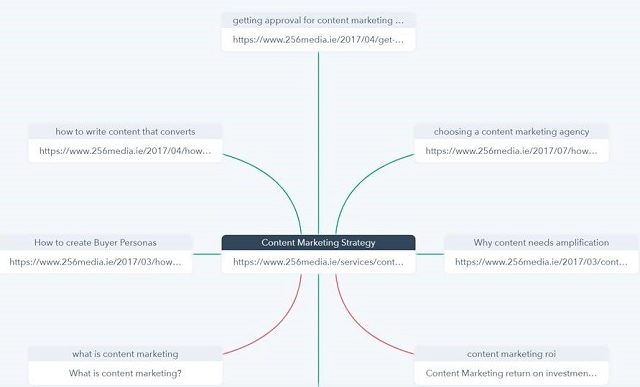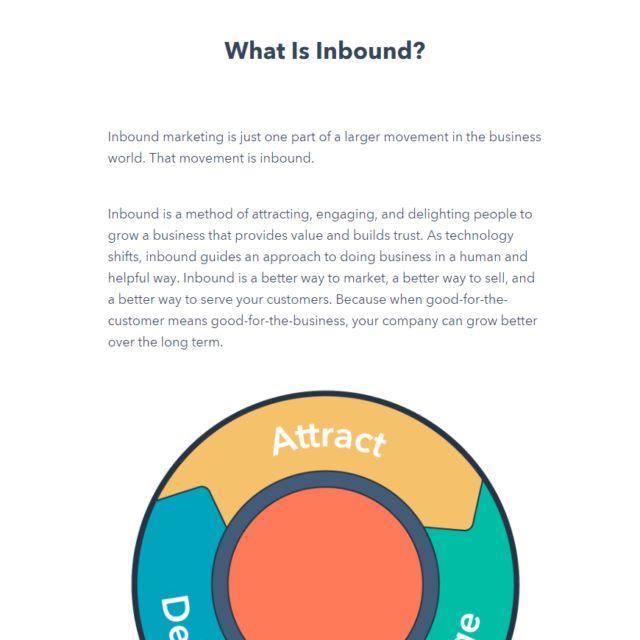Here's what cornerstone content is and how you can create it

Posted by Bryan Arnott
January 28th, 2019
We get it: The whole ‘getting content to rank on the front page’ thing isn’t easy. When your marketing budget is limited to the Eurosaver menu at McDonald’s, it can feel like every other company is throwing theirs around like Jordan Belfort.
But we’ll let you in on a secret. Your marketing budget has nothing to do with getting your company’s content on the front page.
Cornerstone content is one of the ways that companies can communicate critically important information to potential customers. When done right, it can also be a powerful tool in helping your business secure a hallowed spot at the top of Google’s Search Engine Results Pages (SERPs).
While Google tweaks its algorithm every now and then, content marketers can all agree that cornerstone content plays an important
role in getting your content on the front page for the most competitive keywords.
Which is the dream for any marketer, let’s be real.
These long-form, educational articles are essential to cementing your company’s position as a legitimate thought leader in its field (and yes, you are a thought leader – or else what’s the point?) and vault you right towards the top of the rankings.
What is cornerstone content?
Cornerstone content is a blog post, article or landing page that provides readers with comprehensive and exhaustive coverage of a specific topic. It allows your company to show its expertise in action and prove to your
customers why you deserve their trust.
The page should explore an in-depth solution to an issue that’s a common problem among your customer base. These guides will often run over 2,000 words, exchanging brevity for the reassurance that readers won't have to turn anywhere else to get an answer to their question.
Essentially, this page is cornerstone content about cornerstone content. Content-ception, if you will.
But let’s look at a real-life example: If your business sells access to a cloud HR platform, your cornerstone content could be focused on employee engagement or meeting regulatory compliance. These would function as your topics, but they won't always stand alone.
Within that cornerstone content, you might write blogs that give examples of how the top companies approach employee engagement or how they maintain compliance. In doing so your goal is to create an ecosystem of internal links that readers can use to navigate all the articles on a certain topic. The structure for multiple cornerstone content pieces might look similar to a flow chart.
Here's an example of how we built a link-driven ecosystem around the long-tail keyword content marketing strategy using HubSpot:

When it comes to inspiration and information, leave no stone unturned. Talk to your co-workers and snoop around other blogs you admire or competitors you think you can one-up. The lengthy guides are designed to be massive sources of information, covering individual aspects in intense detail and providing unique insights that readers may not be able to get anywhere else.
But here’s the thing to remember: don’t write so much that no one is actually gonna read it. Sure, more words are good for building authority, but ultimately you want to serve the reader and not just Google.
Why is cornerstone content important?
Every business has a purpose, but so does every blog. The problem is that there are too many sources of information available out there – and Google has the difficult job of figuring out which website provide the most comprehensive material to its readers.
Sometimes the search engine can get crowded – like being stuck in the middle of a crowded elevator.
Hang in there, Tay-Tay.
When you Google ‘content marketing’ for instance, you’ll see that there are roughly 2.8 billion results. Not all of them are helpful. In
fact, the majority probably only mention the term in passing once or twice and another bunch are likely trying to sell it more than teach it.
There’s only a select handful of blogs that actually give their readers useful information; the sources that people can rely on. This is the niche that cornerstone content fills. These comprehensive articles are written on key topics that your prospects need help understanding. They serve as the foundation for other blogs and become an important internal link that should be included strategically in similar articles.
Cornerstone content: Give your website's SEO a boost
Any content marketer working in Software-as-a-Service (SaaS) knows how difficult it can be to rank high on Google’s SERPs. It’s a popular industry that’s full of competition, and no matter how many blogs you write, it can feel like the strategy isn’t moving the needle.
Cutting through the noise isn’t an easy task when it’s as loud as a jetliner taking off from the runway. Writing content focused on specialised topics under the umbrella of one large subject only compounds the issue, as the search engine has a difficult time figuring out which one is the most important.
Cornerstone articles make it clear to Google which content your website is striving to be an authority on. It serves as an anchor (which is why it’s sometimes referred to as anchor content) for SEO crawlers to evaluate the website.
In aligning your blog with anywhere from one to five core focuses, you’ll quickly see the following benefits to your SEO strategy:
- A central resource page that draws visitors for a variety of reasons.
- An organised distribution of relevant keywords, with an emphasis on those that directly translate to product or service goals.
- A higher chance at generating organic backlinks that improve its domain authority – or credibility as far as Google is concerned.
Why linking is so important with cornerstone content
One of the reasons cornerstone content is so important for SEO is that Google crawlers use a website’s blog as a site map of sorts. The
search engine needs to be able to see a clear navigation between the most important blog on the topic and the supporting articles that explore niche subjects in greater detail.
Cornerstone blogs fulfil this demand by using an internal link structure that starts with itself and ends at each of the associated
blogs. In fact, the theoretical architecture doesn’t look all that different from the average article:
- The title functions as the overarching goal of the website.
- Each subheader represents the cornerstone topics.
- Bullet points below those subheaders depict the refined
blogs on specific subtopics.
Each new article written on the overarching topic should link back to the cornerstone blog and vice versa. Doing so creates a healthy ecosystem of content that depends on each other to relay a valuable, well-detailed message.
Furthermore, backlinks are just as valuable to an SEO strategy, and cornerstone content can help generate them organically. By providing the industry with useful information that people can use for their own content, there’s a higher chance that they reciprocate by externally linking to the original source – in this case: you.
The chance to earn backlinks increases with the introduction of assets like infographics or videos, or original research conducted through surveys and studies. All of it fuels a more credible domain; rather than simply being a corporate megaphone, it’s seen as a respected resource centre.
5 tips to creating optimised cornerstone content
Marketers are forever trying to reinvent the wheel and cornerstone content isn’t immune to that. While these landing pages are regularly updated to bring them in line with changes in research, in the industry or in SEO in general, there are a few ways you can optimise your article from the get-go.
1. Be careful – but not timid – with your keywords
Make sure that the keywords you want to rank for are relevant and that they’re something your audience actually searches for. Remember – you’re trying to provide value, not create a shrine for your product. Don’t shy away from competitive landscapes either. Cornerstone content is an ideal format to try to outrank your competitors, even if it requires extra effort.
2. Check out the competition
There’s an overwhelming chance that the subject you decide to devote your first cornerstone blog to has already been written about. A lot.
And that’s OK.
The internet is an unwieldy beast and new ideas are hard to come by. But remember what we said about reinventing the wheel? You don’t have to. Instead, aim to do it better – and don’t be afraid to have a good nose at your competitors to figure out how you can trump them.
3. Refine for SEO best practices
Headers, subheaders, meta descriptions with under 155 characters and titles with under 70 characters; these are just a few of the SEO fundamentals every blog needs to have. Be sure that all the checkboxes are ticked here.
4. Revise, revise, revise
Cornerstone content is living and breathing; it should grow with your company and with the topic at large. The blog should be constantly updated to maintain the most current repository of information available on the internet. Plus, you’ll probably notice a few mistakes when you look at your work after taking some time away from it.
5. Make your information easy to find
Google doesn’t like when content is hidden away; it needs to be easily accessible. Cornerstone content should only be one to three clicks away from the homepage and ideally, it should have its own landing page.
Two examples of cornerstone content done right
It helps to understand how successful companies are already using cornerstone content to educate prospects and turn them into marketing qualified leads. Take a look at the page design, where it sits on the website, what sort of information is in the article and which information was left out altogether.
Cornerstone content example 1: Salesforce
Salesforce is a SaaS company that sells a cloud-based Customer Relationship Management (CRM) solution. The tool allows businesses to streamline and better manage the sales process.
The cloud itself can be a confusing concept for those who have little or no experience with it. To help decision-makers better understand how it works, Salesforce created a cornerstone content blog that explains everything people would need to know about the cloud before making a purchasing decision.

Salesforce leverages the readability of an infographic to simplify the complex information and make it easy to digest, knowing that its audience likely isn’t too familiar with the technology. The guide now ranks on the first page of respective Google SERPs. It’s an effective use of cornerstone content in the consideration stage of the buyer’s journey, ensuring that prospects have everything they need on one page.
Cornerstone content example 2: HubSpot
HubSpot is a SaaS company that specialises in providing software for marketing and sales teams. The company is hyper-focused on inbound marketing, which is a move away from the old guard that relied on cold calls, media advertising and email blasts.
The company faces a unique hurdle in that it must educate its audience on inbound marketing so that they can understand the value its solutions hold. HubSpot created a landing page that explores inbound marketing in-depth, entrenching themselves as the authority on the subject.

HubSpot’s cornerstone content is clear and succinct, driving home the main factors that make it so successful. It also does a great job of
You see, you don’t always have to reinvent the wheel to see serious SEO returns. You just have to do it!
Get started with cornerstone content today
Cornerstone content can be an overwhelming but critically necessary part of an effective content marketing strategy. Don’t dive in head-first without a solid plan backing your every decision. Our team can help you put together a comprehensive strategy to help your business become the thought leader it needs to be.

Bryan Arnott

Previous Post
Content is the secret sauce to success with account-based marketing
Next Post

How to stay sane and create content marketing magic
Subscribe Here
You may also like...
Nadia Reckmann | Aug 16, 2024
Nadia Reckmann | May 30, 2024
Nadia Reckmann | Nov 23, 2023





